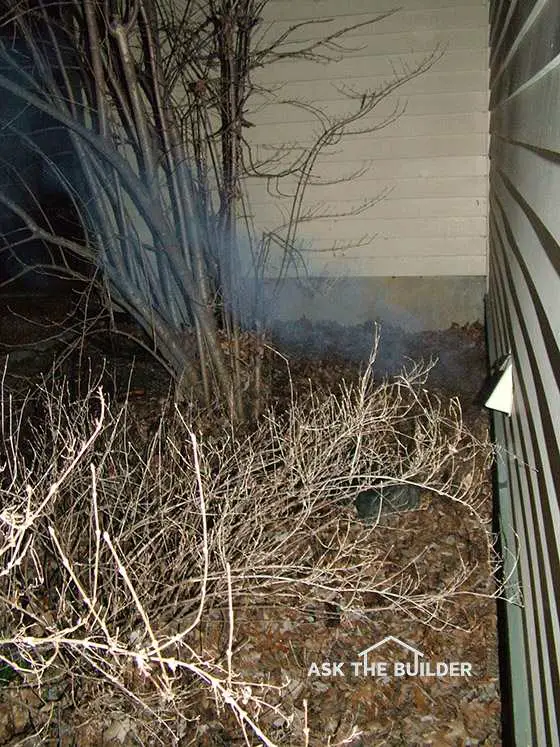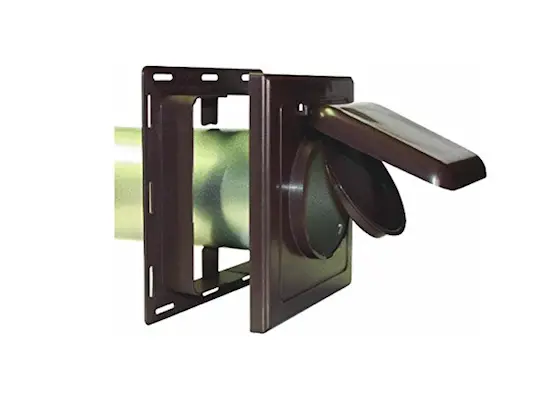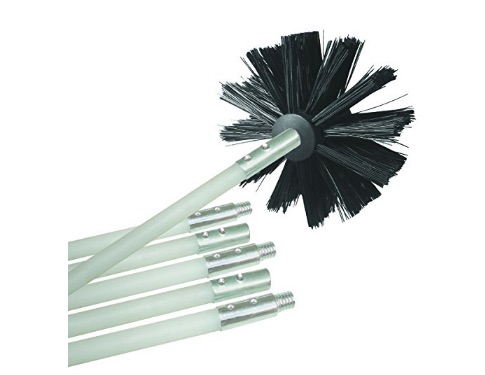Clothes Dryer Venting

Massive amounts of water vapor are belched into the air each minute a clothes dryer is working. © 2017 Tim Carter
Clothes Dryer Venting TIPS
- Exhaust air must go outdoors
- Use smooth galvanized 4-inch pipe
- NEVER exhaust in attic or roof overhang - SEE BELOW
- Roof vent hoods for no-snow areas
- CLICK HERE for Tim's FREE Newsletter - It's funny!
DEAR TIM: My husband wants to vent our clothes dryer directly into our garage in an attempt to keep our cars warmer in the winter months. I think dryer vents should be directed outdoors. Can you settle this clothes-dryer-vent debate? Where would you vent the dryer and what are the top things you would avoid when installing a clothes-dryer vent? Cindy R., Redondo Beach, CA
DEAR CINDY: I get asked so often to referee these marital debates, I am thinking of buying a white-and-black striped shirt. Your husband should be congratulated for thinking of a way to use the waste heat from the clothes dryer, but his proposed method will cause some secondary effects that could end up costing you time, trouble and money.
This may also be a building-code violation in your area, as it is not a good practice to have penetrations in the wall between a house and the garage.
CLICK HERE to get FREE & FAST BIDS from local dryer vent installers.
Water Vapor Bad
Along with all of the heat that would pour into your garage, you also get scads of water vapor. If you have ever seen a clothes-dryer vent belching out a plume of water vapor on a cold winter day, you know this might be problematic.
All of the liquid water that was in the clothes will get sent into the garage, if your husband implements his idea. This water will undoubtedly condense on all of the cool surfaces in the garage causing rust and corrosion on any unprotected steel tools or parts.
Condensation and Lint
But the water vapor will also condense in places you can't see. You may end up with water and mold issues inside of your garage walls and in an attic space above the garage. Wood rot is a distinct possibility if this water vapor discharges into the garage for any length of time. Lint will be everywhere in the garage as well.
Dryer vents, and the importance of doing it right, are a very misunderstood aspect of home building and remodeling. Many people underestimate the thousands of cubic feet of air that are expelled by a clothes dryer each time it dries just one load of clothes.
Vent Outside
This air must be exhausted outdoors as your intuition told you. But this doesn't mean you can't capture some of the heat before you exhaust the air.
I've found that it is often best to vent fans and dryers through the roof if you live in an area with little, or no, snow.
I urge you to watch this video of mine to see how easy it is to install the correct vent-cap flashing on a roof. Have no fear - if done right you will have no leaks.
Side Wall Best
I always say to vent clothes dryer exhaust outdoors. You can do this sideways through a wall or up through a roof as hot air rises with ease. The most important thing to do is read all of the written instructions that come with a clothes dryer and follow them to the letter. The instructions often describe in great detail the preferred pipe to use and the configuration of the pipe as it makes its way from the back of the dryer to the outdoors.
CLICK HERE to get FREE & FAST BIDS from local dryer vent installers.
Smooth Metal Pipe
Almost every clothes-dryer manufacturer will tell you to use smooth metal pipe as the venting material. This pipe should be 4 inches in diameter and extend some maximum distance. Each manufacturer will state how long the vent pipe can be. You need to do some math, as 90-degree fittings that allow you to turn corners must be accounted for in the calculation. A single 90-degree fitting usually equals 10 feet of straight pipe.
If you live in a cold climate, you may want to think about how to reclaim heat from your dryer. This will save you some money on your heating bills. The way to do this is to use metal pipe inside your home and allow it to act like a radiant heater or a car radiator in reverse.
Harvest Heat!
To extract heat from a simple clothes-dryer vent, try to install the metal vent pipe so it is near or at its maximum length indoors. If you have the luxury of an unfinished basement, you may be able to run the metal vent pipe at a slope from the dryer to a window that is perhaps 20 feet away. The hot pipe radiates the heat directly into your basement along its entire length.
You may be able to fabricate a crude heat exchanger using some scrap sheet metal. But if you do this, be sure it is made with a door that allows you to open it to check for lint buildup. Fires that feed on clothes-dryer lint are a reality, and you must always make sure your clothes-dryer vent is free of lint buildup.
Insulate Pipe in Cold Space
It's very important that the clothes-dryer vent is well insulated if it passes through a cool or cold space like a crawl space or attic on its way to the exterior.
If the pipe is not insulated, water can condense on the inside of the vent causing leaks or poor dryer performance if the pipe becomes filled with water. This water can leak and drip down onto ceilings or soffits.
Best Vent Hood
The best dryer vent hoods in my opinion are the ones with double doors. I have two at my own home, one that's used for a bathroom exhaust fan so it stops cold air from backdrafting into my home. The image below is the one I used. CLICK THE IMAGE or CLICK HERE to order one right now.

Look at the double doors. This keeps pests out and prevents cold air from backdrafting into your home. CLICK THE IMAGE to order it now.
Beware Soffits & Overhangs!
Avoid installing the dryer-vent termination cap in a soffit overhang under a roof. The clouds of water vapor can easily find their way into the attic through soffit vents, cracks or any other small opening. This water vapor will condense on the cold lumber in the attic. I have seen photos of frost one-half-inch thick that has coated large areas of an attic. Other photos have shown a plume of black mold on the underside of the roof just above the soffit where the dryer vent exits the house.
You can readily purchase dryer-vent roof caps that connect to the 4-inch smooth metal pipe. These caps have a damper that keeps animals out of the pipe. They do require periodic maintenance to ensure lint does not clog the damper leaving it partially open.
No Indoor Vents!
Beware of the dryer-vent kits that say you can exhaust the air inside your home. For them to convert all of the water vapor to liquid water, they would have to be equipped with a very large refrigerated coil as part of the system. Without this coil, vast amounts of water vapor invade your home.
Cleaning Dryer Vents
Lint can build up in a dryer vent pipe. I once had to move a vent pipe for a single mom and the entire pipe was choked with lint.
The dryer will not function properly if the vent gets reduced in size by lint buildup.
Use the following great brush to remove lint from your dryer vent pipe.

This is a fantastic product to clean out your dryer vent. CLICK the photo to have it delivered to your home in days.
CLICK HERE to get FREE & FAST BIDS from local dryer vent installers.
Related Column: Your Pesky Dryer Vent Pipe
This column was featured in the January 22, 2013 AsktheBuilder Newsletter.
Column 714
32 Responses to Clothes Dryer Venting